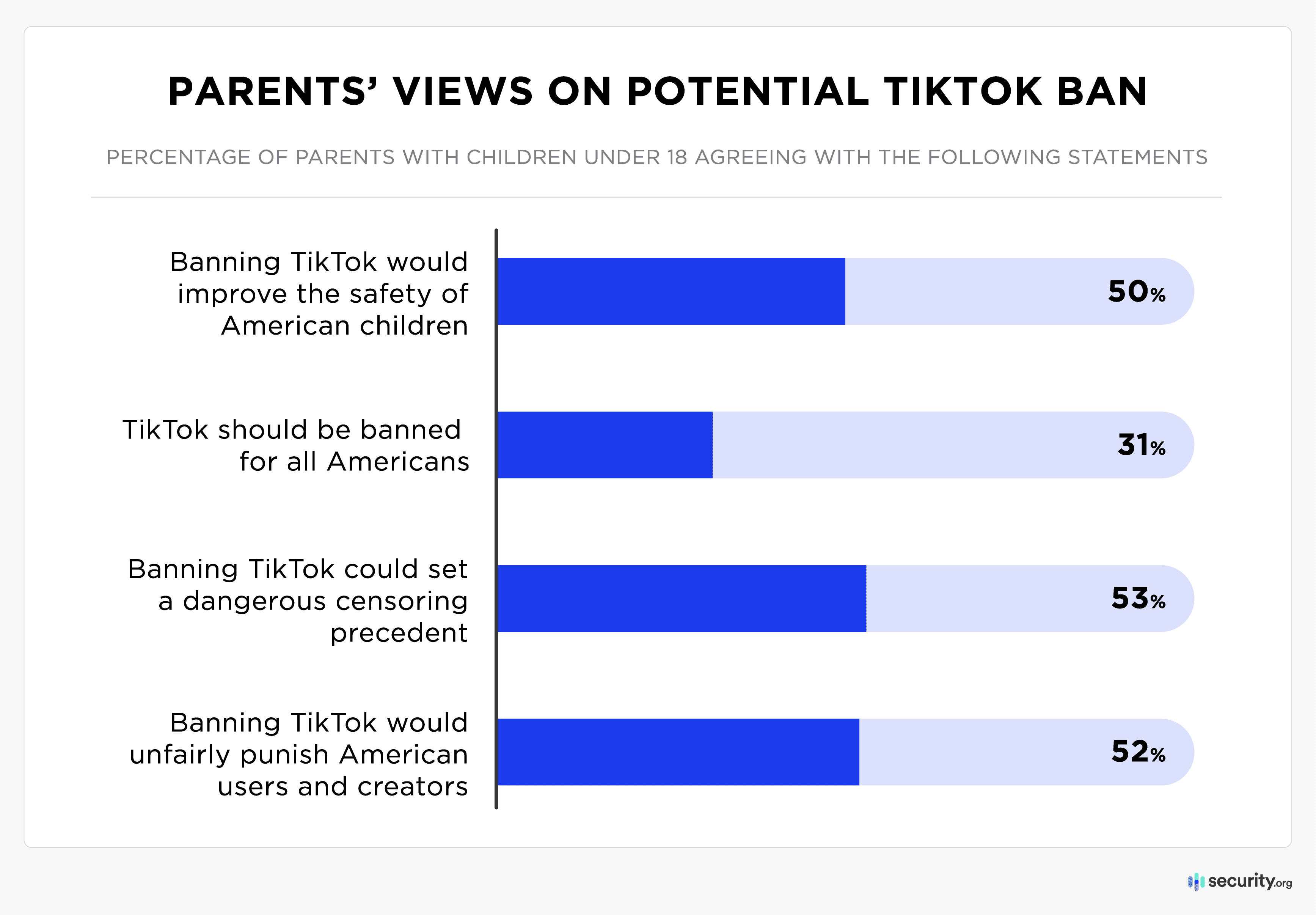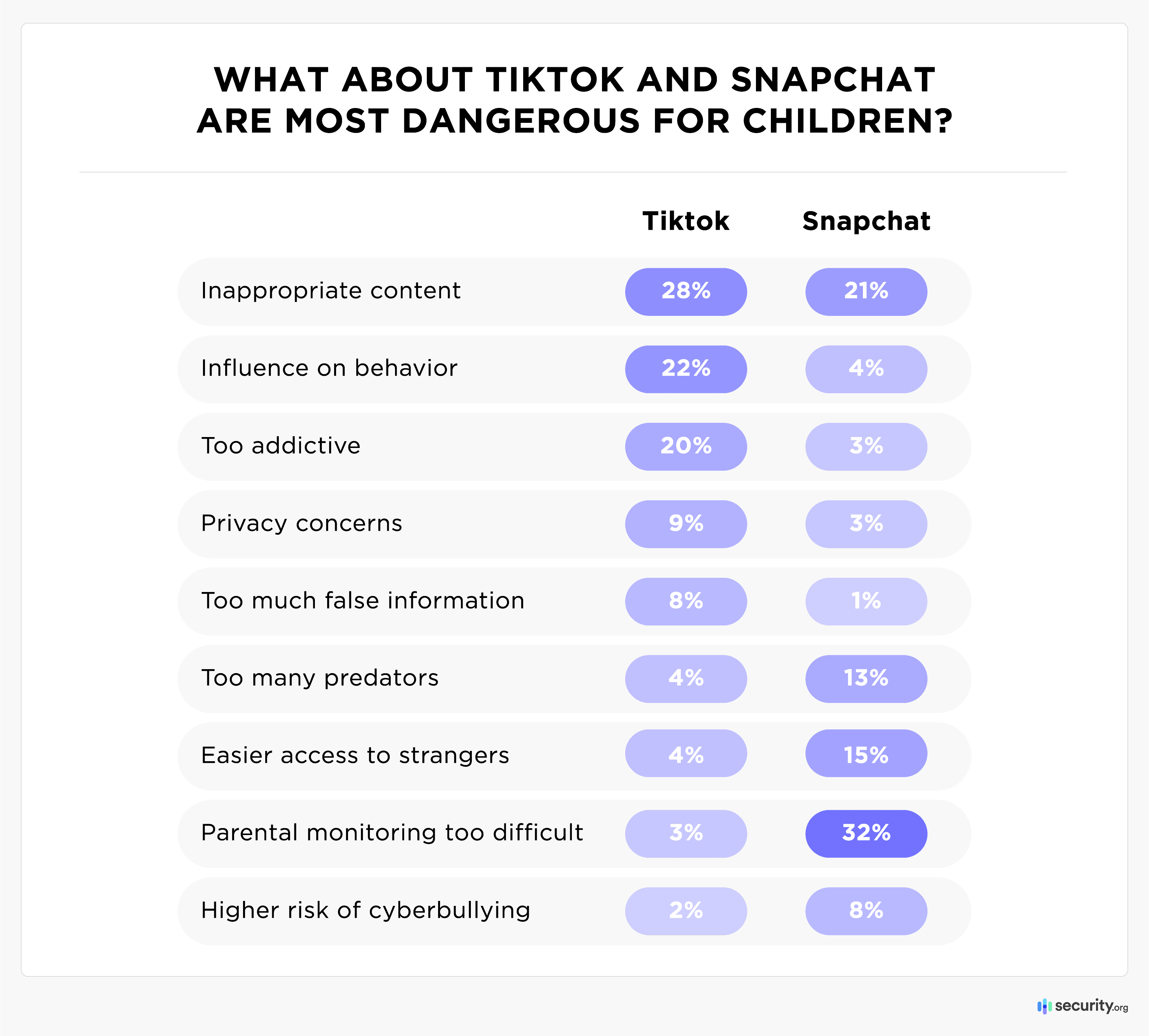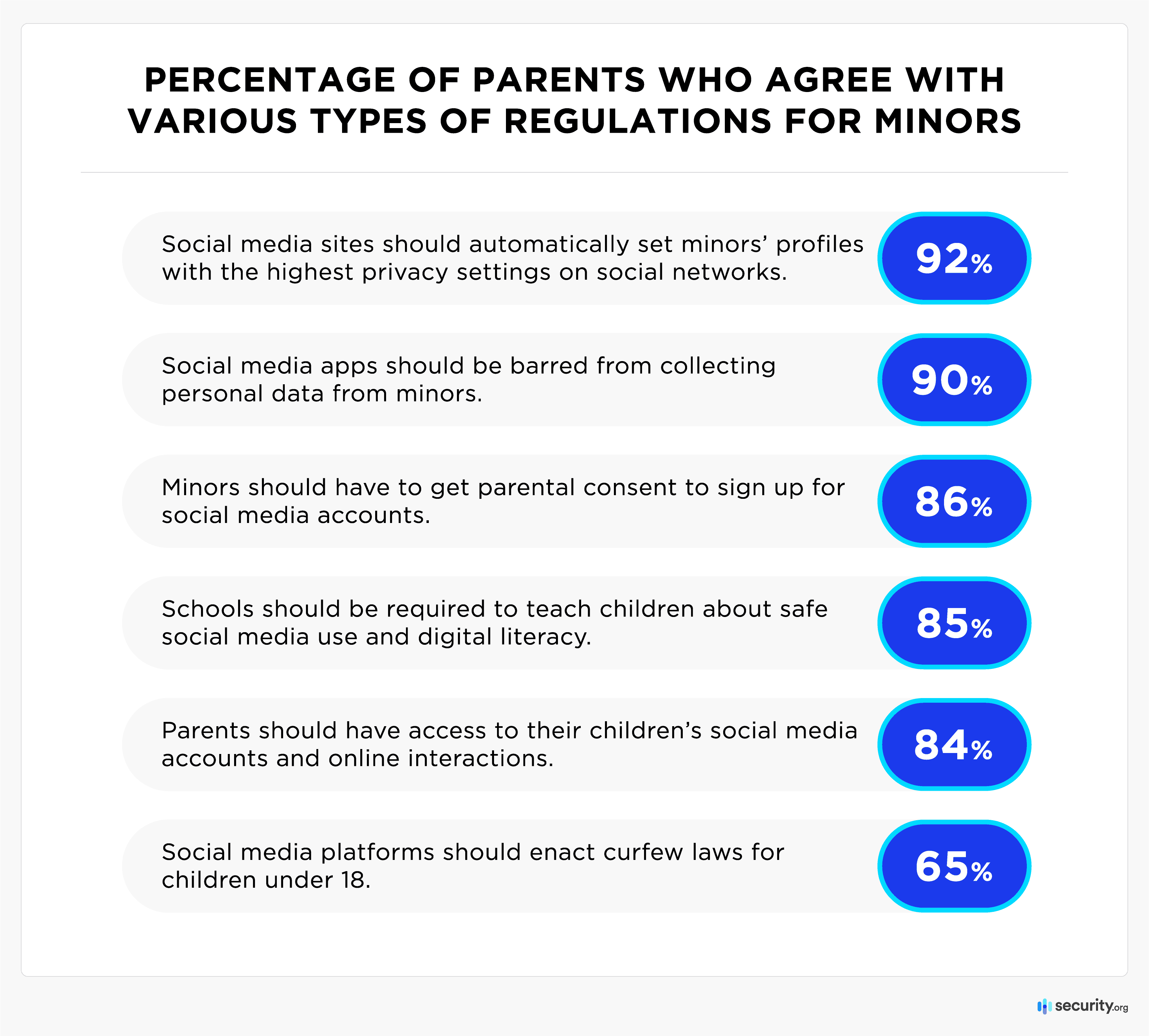50% of American Parents Think a TikTok Ban Would Make Kids Safer Online
67% of parents believe children under 18 need more legislative protections from the dangers of social media.
Though TikTok narrowly escaped an all-out ban in the U.S., the future of the wildly popular social media platform is still uncertain. Among that app’s 170 million domestic monthly users, over 50 million are under age 15. Many of these youngsters use social media almost constantly, risking their privacy, safety, and mental health.
Several social media platforms have pledged to roll out additional safety features, but parents demand more proactive measures. Some states, like Florida, have passed strict regulations governing underage access to social media sites.
To better understand how and if parents want the government to help protect their kids online, Security.org conducted a study of nearly 1,000 Americans with children under 18. Here are some of our key findings:
- Currently, only 31% of parents support a TikTok ban for all Americans, but 50% believe such a ban would improve children’s safety.
- 25% of parents consider TikTok to be the most dangerous social media platform for children, due to inappropriate content and its influence on their behavior.
- 67% of parents believe children under 18 need legislative protection from the risks of social media.
- 86% of parents support laws requiring children under 18 to obtain parental permission before joining social media platforms. 84% support laws that would grant them complete access to their children’s accounts and 85% feel schools should be required to teach children about social media safety.
- Nine out of ten parents want to bar social media companies from collecting personal data from minors.
Table of Contents
Half of Parents Feel Banning TikTok Would Make Their Kids Safer
The most resounding findings from our latest research concerned parents’ apprehensions about social media’s impact on kids. More than 90 percent of Americans with minor children worry about social media screen time, content, and the health impacts of social media on their kids.
The U.S. government is also concerned about the impacts of social media on Americans’ mental health and their privacy. Congress has already initiated a process that would ban TikTok or divest it of overseas ownership (in part to protect children, but mainly due to national security concerns). While half of parents believe outlawing TikTok would promote child safety, only about a third support a complete ban for all Americans.
Those hesitant to ban TikTok completely cite concerns about free speech and misgivings about unfairly punishing app users and creators. These worries echo some watchdog warnings about opening the door to more censorship.
If the divest-or-ban law is upheld by the U.S. Supreme Court, some TikTok users are ready to workaround the ban to access the beloved social media site. A new Security.org poll found 37 percent of TikTok users are likely to use a VPN to try to access TikTok if it’s outlawed in the U.S.
Parents Feel TikTok and Snapchat Are The Most Dangerous Social Media Sites for Kids
Though American parents are split about whether TikTok should be banned, there’s no doubt that many consider the platform to be dangerous for their children. Nearly a third of parents believe all social media platforms to be equally dangerous, yet most view certain networks as more threatening than others. Parents consider TikTok and Snapchat as the most menacing platforms by far. Unfortunately, they are also the two most popular services among teens, after YouTube.
| Which social media platform is most dangerous for children under 18? | Percent of parents with minor children |
|---|---|
| All of them are equally dangerous | 31% |
| TikTok | 25% |
| Snapchat | 20% |
| Discord | 4% |
| 4% | |
| 4% | |
| 4% | |
| 2% | |
| YouTube | 2% |
| None of them are dangerous | 2% |
| 1% | |
| Twitch | 1% |
Parents ranked inappropriate content as the prevalent danger of social media, with other concerns including predators, addiction, and bullying.
TikTok concerns centered around behavioral influences and the app’s addictive nature (mainly due to its notoriously infectious algorithm). Snapchat was cited as too difficult for parents to monitor, likely because its vanishing messages render viewed content impossible to trace.
Parents appear more comfortable with less severe regulatory tactics, such as laws limiting children’s access rather than completely banning certain networks for everyone. Two-thirds back social media “curfew laws,” like the one passed in Utah in 2023. That legislation blocks younger users from accessing platforms between 10:30 p.m. and 6:30 a.m. but allows parental exemptions, giving families ultimate authority. Similar codes in Ohio, Arkansas, and California are wrestling with legal challenges. Several other states are considering bills of their own.
2 in 3 Parents Believe Laws Are Needed to Protect Kids Online
Currently, four in five parents believe that social media use causes depression, anxiety, and psychological distress in young people. A staggering 98 percent believe social networks are dangerous for children under 18 – a concern shared by medical professionals.
Given the detrimental effects of social media, approximately 67 percent of parents believe legislation is necessary to protect children from social media today. Last year, 68 percent of parents felt similarly. Parents stand ready to translate their anxiety into tangible action, but no single solution garners universal support. Sentiments vary between placing the burden on the government, the platforms, or personal accountability.
Some parents support regulations governing platforms’ handling of underage accounts. More than 80 percent want consent requirements for account creation (like a bill just signed into law in Florida), along with complete access to their children’s profiles and interactions. Approval rates exceed 90 percent for assigning children the highest privacy settings and prohibiting the harvesting of their personal data.
Despite the wide support for the policies above, 37 percent of respondents felt that government laws controlling online behavior infringe upon parental rights.
The recently revised Kids Online Safety Act (KOSA) is proposed legislation incorporating several of the desired components mentioned above. This federal law would impose a “duty of care” upon social media companies, holding them accountable for childhood harm caused by their platforms.
Specific KOSA provisions include:
- Higher privacy settings for children.
- Ability to opt out of targeting algorithms and data collection.
- Curbing strangers’ communication with minors.
- Making child safety features accessible via parental controls.
The bill was passed by the Senate, and the House passed a slightly different version. Alternate propositions, as well as opposition by the tech industry and free speech advocates, threaten to impede congressional passage.
How to Protect Children on Social Media
Given today’s social and logistical landscape, most young people will eventually possess smartphones and access social networks. How parents introduce, address, and monitor that journey greatly influences how children handle the online environment. Experts suggest some considerations for parents to help their kids navigate social media’s risks.
- Educate yourself on social media: Understanding social media’s dangers is critical for parents and children alike. We found that 85 percent of parents believe schools should teach children about safe social media use and digital literacy, but parents must also educate themselves. When all parties know the possible pitfalls, families can have productive, fact-based discussions that openly address the risks.
- Remember that every child has unique needs: Each child will need different levels of support when navigating the internet, and no one knows them like you. Base your decisions on when they get a phone, which networks they join, and what they can handle based on their unique personality. Introduce online interaction gradually, starting with family communications only. Keep kids away from platforms featuring more toxic interactions, especially in their demographic (for instance, Instagram can be notoriously challenging for teen girls).
- Establish a family technology contract: Families should establish ground rules that clearly define appropriate parameters for social media use. Instead of purely dictating harsh restrictions, consider drawing up a “media contract” that’s reasonable to you and your children. Then, methodically enforce the provisions. The contract should focus on preserving quality time without screens as a family. Set aside hours around meals, homework, and bedtime when devices are all powered down. Additionally, parents should model positive behavior by regularly setting their own devices aside to connect with their kids.
- Supervise your children’s social media use: Parents should be part of onboarding when they permit children to join a new social network. During signup, parents can check that accounts are secure, turn on the highest privacy settings, and enable parental controls where appropriate. Parents comfortable with external monitoring and controls should familiarize themselves with tools like Family Sharing (Apple) and Family Link (Android) to track and limit online hours.
- Work together with friends and extended family: Peer pressure and envy often drive children to reject internal family rules. Building relationships with parents in your children’s social circle can help create a shared understanding and normalize established rules. When communities establish standard social media guidelines, it helps ensure that everyone follows them, reduces peer pressure, minimizes resentment, and discourages rule-breaking.
- Watch out for red flags: Parents should be alert for signs of distress once their children use social media. Pay attention to energy, sleep patterns, moods, and the intensity of their connections to screens. Don’t be overly critical, oppressive, or clinical—strive for an open relationship where they can come to you with questions or confessions about abuse and bullying. Reporting harmful behavior to the appropriate authorities, such as other parents, schools, platforms, or law enforcement, is crucial to protect potential victims and address the issues effectively.
- Teach Privacy and Security: By teaching your kids the importance of privacy and security, you can all avoid them oversharing and trusting strangers online. This can also set them up for a safer and more secure digital future.
- Open Door Policy: Practicing open communication with your children will make them feel more comfortable discussing their online activities and experiences with you. Maintaining open dialogue can help you help them navigate tricky situations and make safer choices.
- Know the Latest Social Media Trends: Social media is constantly evolving. Keeping up with trends can help parents stay informed and better understand their child’s experiences online.
- Offer Alternative Offline Activities: A great way to keep your kids safe online, is to limit how much time they spend on their devices. However, this can often backfire and damage communication lines and trust between parents and kids. Instead, do this in a smart way by involving your child in activities that don’t include screens, like reading, sports, art, music lessons, hobbies, or just spending time outside.
Conclusion
Though the movement to ban TikTok currently dominates headlines at the intersection of adolescent health, national security, and politics, protecting children on all social networks deserves more serious and constructive attention.
Nearly all parents acknowledge that social media platforms pose dangers for their children, and two-thirds demand legislation addressing the threat. Even higher numbers support specific regulations: expanding education, restricting hours and data mining, and requiring parental consent.
Beyond the TikTok ban, other federal measures (like KOSA) may soon enact such protections. Additionally, several states are taking matters into their own hands with local laws designed to safeguard children. Perfect answers aren’t apparent, and must ultimately balance privacy, safety, free speech, and enterprise. In the meantime, families can implement their own precautions, but our children remain at risk.
Our Data
In March 2024, Security.org conducted an online survey of 996 American adults with at least one child under age 18 about their experiences, concerns, and expectations regarding their children’s use of social media.





